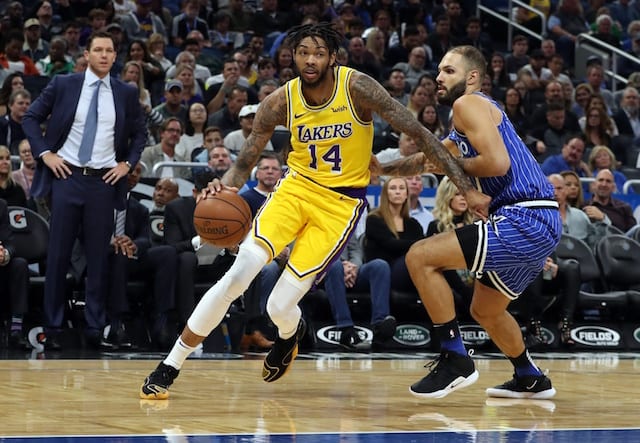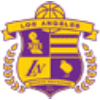Soon, the Los Angeles Lakers will see Brandon Ingram and Rajon Rondo return to the court following ankle and hand injuries, respectively. It’s a welcome sight for a team that, as LeBron James lamented following a bad loss at the hands of the Washington Wizards, is “built on energy and depth.”
On that night, with JaVale McGee (illness) and Michael Beasley (personal reasons) also sidelined, the Lakers were dead in the water, providing Washington with the one thing that can’t be given to bad teams — hope.
The Lakers, now fielding a skeleton lineup, are badly in need of fresh legs and energy. In that way, Rondo and Ingram can’t come back fast enough. That said, head coach Luke Walton will have to navigate their returns carefully.
Ingram will have missed almost all of eight games before his potential return, while Rondo will have been sidelined for 17. In that time, the team has moved on and on-court chemistry has changed — perhaps for the better.
Rondo has largely seen his role as the reserve point guard replaced by committee, with LeBron James, Lance Stephenson, and Svi Mykhailiuk having spent time initiating the offense in addition to starting point guard Lonzo Ball taking on more minutes.
Thus, Rondo’s role is easily defined; he can slide back into his old spot and hopefully bring some balance to an inconsistent bench squad.
Ingram’s return, on the other hand, will have Walton wading into waters than even Jason Momoa might think twice about venturing into.
The Lakers’ starting five is better when Josh Hart starts at shooting guard in Ingram’s place. At this point in the season, small sample size isn’t as big of a factor, and the numbers are painfully clear.
With a starting five of Ball, Hart, James, Kyle Kuzma and McGee, the Lakers have a net rating of 15, which is the highest of any five-man unit that has appeared in at least nine games. Replace Hart with Ingram and that starting unit drops all the way down to a net rating of 0.2, which happens to occupy the bottom spot on the list.
With Hart, the starters play faster, shoot more efficiently, turn the ball over less, get more steals and more assists. They are also stingier on defense, in part thanks to the better looks they are generating on the offensive end leading to fewer opportunities for opponents to run.
Hart, who is one of the Lakers’ best 3-point shooters, helps burn teams that drop into the paint to deal with a James drive, Kuzma spot up or cut, or one of McGee’s rolls to the rim. Ingram,
who is shooting just 32 percent this season from deep, has neither the efficiency not the willingness to be the kind of sniper that can camp out behind the arc and keep the defense scrambling.
Additionally, Kuzma has thrived sans Ingram, averaging 22.9 points on 52 percent shooting to go along with 6.4 rebounds and 3.6 assists in the seven games that he has been the clear-cut sidekick to James. The ball moves a bit more freely, allowing Kuzma to reap the benefits on backdoor cuts and curls through the lane, taking advantage of the extra space.
Even James’ numbers show that Ingram hasn’t been the splash-and-slash partner that we all dreamed of when the two greeted each other courtside during Summer League this past July. On average, James throws 11.8 passes per game to Kuzma, which generates 2.2 assists on average, the most of any James target by a large margin.
Ingram, on the other hand, receives just 6.7 passes per game from James, resulting in just 0.5 assists. All that being said, it should be noted that none of this means that Ingram is a bad player.
On the contrary, while his dip from 39 percent from three last season to just 32 percent this season is a concern, he’s still the spider-limbed, versatile wing that NBA teams covet. His endless arms can contest shots that few can bother while his surprising abilities as a playmaker allow Ingram to effectively masquerade as a point guard when the situation calls for it.
The problem isn’t the player, it’s the fit. While most, myself included, believed that Ingram would adapt well to playing alongside James, so far it has been a difficult transition thanks, in part, to how similar the two are.
Despite all the talk over the summer about how surrounding James with playmakers would, at his request, take some of the offensive burden off, James’ usage rate with the Lakers is identical to last season with the Cleveland Cavaliers.
He’s shooting the ball a little more often (20.3 shots per 36 minutes, up from 18.8) and thus, picking up fewer assists (7.2 per 36 minutes, down from 8.9), but for the most part, James is going what he has always done: control the game by orchestrating the offense with the ball in his hands.
Unfortunately, that’s also the role that Ingram thrives in. Where Kuzma is content to cut without the ball, or catch on the perimeter and either fire a 3 or attack the basket, Ingram wants to probe the defense, find a seam, and then either get to the rim, pull up, or kick to an open teammate.
It’s because of these tendencies that Ingram thrives as a creator, but given that James occupies that role and won’t be relinquishing it anytime soon, inserting a catch-and-shoot player like Hart for the arguably more talented Ingram results in better basketball.
Overall talent matters in the NBA, but sometimes fit matters more, and that appears to be what’s happening here. Perhaps things change with time and eventually, Ingram will be able to adapt to playing alongside James, but in the ridiculously deep Western Conference, the Lakers have pressure to win games now and statistically, Hart gives them the better chance of doing that.
Thus, Walton is faced with a conundrum. Having Ingram play the majority of his minutes off the bench in order to minimize his time on the floor with James makes all kinds of sense statistically, but it would be seen as a demotion and one that Ingram hasn’t been keen on in the past.
The Lakers are invested in Ingram’s future, whether it’s as part of the young core or as a trade chip to be cashed in when the time comes to bring a second — or perhaps third — star to Los Angeles. Somehow, Walton has to find a way to keep Ingram happy, his value high, and the team playing at it’s best–a tall order, to say the least.





